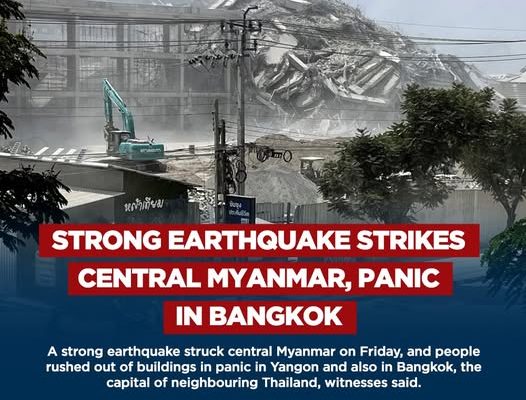On the evening of March 28, 2025, a devastating 7.2-magnitude earthquake struck Myanmar, sending shockwaves across the region and causing widespread destruction in neighboring Thailand. The earthquake, which occurred at approximately 8:15 PM local time, was centered near the border between Myanmar and Thailand. The tremor was felt across several cities in Myanmar and parts of northern Thailand, sparking fears of severe damage and casualties as buildings crumbled and infrastructure was heavily impacted.
The Earthquake’s Impact on Myanmar
Myanmar, already dealing with political turmoil and challenges related to its ongoing internal conflict, faced a new catastrophe with the earthquake’s powerful shake. The epicenter, located near the city of Tachileik in Shan State, rattled major towns, including Mandalay and Yangon. The tremors were so intense that they were felt across the entire country, leading to widespread panic.
Reports from emergency responders and local authorities indicated that multiple buildings, including residential complexes, commercial buildings, and older structures, had collapsed. The most severe damage occurred in the city of Tachileik, where several large buildings came down, trapping residents and workers under the rubble. The local hospital has been overwhelmed with patients, many suffering from broken bones, lacerations, and head injuries. Rescue teams have been dispatched to the hardest-hit areas, but access to certain regions remains difficult due to collapsed roads and damaged infrastructure.
As the situation continues to unfold, local authorities have raised concerns about the potential for aftershocks, which could cause further structural damage to weakened buildings. Myanmar’s government has mobilized the military to assist with rescue operations, and international aid is expected to arrive in the coming hours to provide much-needed support for the affected regions.
Effects on Thailand
The earthquake’s reach extended beyond Myanmar, with tremors felt in northern Thailand, particularly in the cities of Chiang Mai and Chiang Rai. Buildings in the region were not as severely impacted as those in Myanmar, but there were reports of damaged structures, with some older buildings and bridges sustaining cracks and minor collapses. In Chiang Mai, several buildings in the city center were evacuated as a precaution, and residents took shelter outdoors to avoid potential hazards from aftershocks.
While the scale of destruction in Thailand was not as severe as in Myanmar, the country has still seen significant disruptions. Power outages were reported in some northern provinces, and transportation in the region has been significantly affected, with roads damaged and railway services temporarily suspended. Thai authorities have urged the public to remain vigilant as seismic activity continues in the area.
The Response and Relief Efforts
In the wake of the earthquake, both Myanmar and Thailand’s governments have activated emergency response protocols to manage the crisis. In Myanmar, the National Disaster Management Committee has issued statements calling for immediate relief efforts, including the provision of medical aid, food, water, and shelter for displaced people. The military has been tasked with search-and-rescue operations, and many international organizations, including the United Nations and the Red Cross, have pledged to assist with recovery efforts.
In Thailand, the government has set up emergency shelters and medical stations to support those affected by the quake. The Thai Ministry of Public Health has deployed teams of doctors and nurses to the northern provinces to treat the injured and help local hospitals manage the influx of patients. The government is also working with international partners to assess the damage and provide additional resources for recovery.
The earthquake has placed additional strain on both countries, which are already grappling with the impact of natural disasters in recent years. Both nations will likely need significant international assistance to rebuild infrastructure, support victims, and stabilize the affected areas.
Future Concerns and Preparedness
As authorities continue to assess the full extent of the damage, the focus will likely shift to longer-term recovery and rebuilding efforts. Both Myanmar and Thailand will face challenges in dealing with the aftermath of the earthquake, from restoring critical infrastructure to providing long-term support for displaced populations. Given the region’s vulnerability to seismic activity, experts are urging both governments to strengthen their disaster preparedness and response strategies to mitigate the impact of future natural disasters.
The earthquake in Myanmar and Thailand serves as a grim reminder of the destructive power of natural forces and the importance of building resilient infrastructure and communities. In the days ahead, the international community will likely play a crucial role in supporting recovery efforts, helping the affected nations rebuild and recover from this tragic event.
